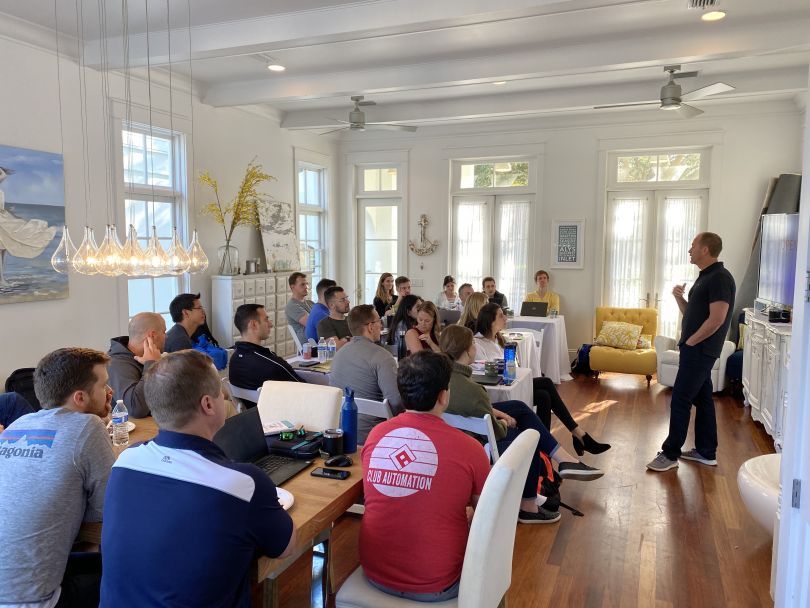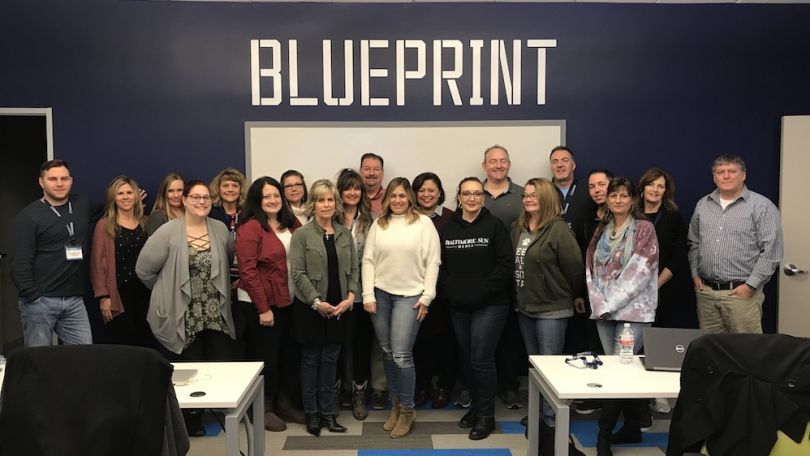More often than not, a fully informed decision is a smart decision.
Just ask the directors and managers at the following companies who implemented a sales enablement strategy into their existing pipelines. In order to provide their front-line team members with additional sales support, they expanded company playbooks, turned to outside resources, paired newer employees with sales veterans and more.
What is Sales Enablement?
But all of that effort would have been negligible if they hadn’t been able to get buy-in from stakeholders in marketing and sales.
“All the processes and enablement tools in the world do not have value until they become adopted and implemented,” said Club Automation VP of Sales Nick Thornton. “People are your most valuable asset, and the sales tools must empower them to be more productive and achieve great results.”
The professionals we spoke with had to make sure every department was on board with the enablement strategies outlined below from the start. Now, they can count on the support of those teams moving forward.
Tools For Building A Sales Enablement Strategy
- Define your sales process
- Establish clear expectations and goals
- Keep the training process uniform and by the playbook
- Master your CRM platform
- Document and understand each step of the buyer journey and its possible outcomes
- Utilize call recording and analytics technology

ENVOY
Envoy
Envoy Corporate Sales Director Mere Hess said the leadership team counts on sales representatives to understand which approach is best to use for a particular client. According to Hess, employees have the tools they need –– including the sales playbook –– to make informed decisions on their own. Below, she and Senior Vice President of Business Development Steve Brown shared the importance of ensuring the company’s brand messaging reflects its mission.
When it comes to building a successful sales enablement strategy, who are the key stakeholders that need to be involved and how do you create alignment across those different departments?
Our team has the unique opportunity to work across departments with marketing, service teams, finance, technology and even HR. We often rely on a team sales approach. The people backing our software are crucial to our success. Knowing that, we often loop in the service teams during the sales process to highlight ways in which our approach is different from traditional immigration firms. Given that our software is so unique to the space, we also work heavily with marketing and product to get our messaging and key differentiators out there.
When onboarding with Envoy, the sales playbook is one of the first tools a new hire will learn.’’
What sales enablement tools, resources or processes have you found to be particularly important for helping your salespeople succeed?
Envoy’s sales playbook outlines the sales process and best practices for the sales floor. When onboarding with Envoy, the sales playbook is one of the first tools a new hire will learn. We count on our salespeople to understand the prospect to prioritize the right approach, so training on the playbook framework is key. Additionally, our sales team relies heavily on our marketing department to provide content that is relevant to our buyers. Immigration is an ever-changing landscape. It is important that our resources reflect those changes.

MOLO SOLUTIONS
MoLo Solutions
In order to help their salespeople succeed, leadership at MoLo Solutions has provided employees with access to buyer personas, content releases and industry insights, all housed in internal learning centers. Manager of Content Jacob Tache said this sales collateral has been foundational to establishing team members as consultative partners in the industry.
Who are the key stakeholders that need to be involved in building a sales enablement strategy?
An effective sales enablement strategy is built on information that we know is relevant to customers. It hinges on a hierarchical buy-in from marketing and sales leadership, beginning with C-suite members and stemming down to managerial stakeholders. Understand the respective priorities and current strategies used to create alignment between departments and help determine where resources can be leveraged to drive results over time.
With objectives outlined, marketing can work with sales to create a platform necessary to fast-track sales representative development. We aim to establish each team member as consultative partners within their industry.
We aim to establish each team member as consultative partners within their industry.’’
What sales enablement tools, resources or processes have you found to be particularly important for helping your salespeople succeed?
Any sales enablement strategy should establish a formal process for gathering the right and relevant information. It should manage and track the performance of content materials. The sales enablement plan should consist of clear expectations as well as a strategy to execute on goals. Bear in mind, the plan should be flexible and be able to adapt to buyers’ changing needs.

Club Automation
When leadership at Club Automation went about putting a sales enablement strategy in place a matter of months ago, they made sure to get buy-in from department managers throughout the company. Vice President of Sales Nick Thornton said that willingness across the board, as well as defined outcome documentation, was key to making the strategy successful.
Who are the key stakeholders that need to be involved in building a sales enablement strategy?
Over the last two years, Club Automation has grown from 11 sales team members to a team of 30. Formulating a sales enablement strategy was critical to the growth of our sales team and our ability to increase sales productivity. We had an agnostic senior leader who was able to think strategically and sponsor the project. We included individuals from sales, marketing, finance, legal and support. It’s imperative to find team members who are open to change and have a willingness to listen and understand.
All the processes and enablement tools in the world do not have value until they become adopted and implemented.’’
What sales enablement tools, resources or processes have you found to be particularly important for helping your salespeople succeed?
The most important step of building a sales enablement strategy is documenting each step of the buyer’s journey with defined outcomes. This allows you to understand the tools you will need to generate the outcomes you’re seeking. A CRM is a critical implementation tool. It will enable you to organize your prospects and clients while tracking sales opportunities through a pipeline.
All the processes and enablement tools in the world do not have value until they become adopted and implemented. People are your most valuable asset, and the sales tools must empower them to be more productive and achieve great results.

Tribune Publishing
When training their sales reps and key stakeholders, Tribune Publishing leans on the Blueprint sales methodology. In addition to implementing behavioral changes with big impact, Sales Enablement Director Stephen Buergey said the team practiced coaching sessions and stalled deal reviews.
Who are the key stakeholders that need to be involved in building a sales enablement strategy?
A successful sales enablement strategy must start with a common sales methodology and a consistent playbook. Simply put, everyone on the team needs to be speaking the same language and executing from a similar game plan.
Some of the key stakeholders include senior sales leaders, marketing leaders, sales directors, training leaders, sales operations leaders and sales enablement leaders. We have adopted the Blueprint sales methodology and have sent our key stakeholders and most sales representatives through the training program. During this training and through constant reinforcement, the sales playbook is communicated.
Effective sales enablement tools must meet learners where they are in their roles.’’
What sales enablement tools, resources or processes have you found to be particularly important for helping your salespeople succeed?
Effective sales enablement tools must meet learners where they are in their roles. Today’s sellers consistently ask for content that is short yet effective. One tool we use is LUCi (powered by Seismic). LUCi is a file repository platform that allows users to access files and videos on their own time.
In Q1, we plan to launch a learning and practice platform. We are using Lessonly to deliver engaging and brief content, and we utilize the practice module to ask learners to teach back via video. It’s already been implemented in our Chicago market.

WhiteSource
When giving sales reps at WhiteSource the tools they need to succeed, General Sales Manager Azi Cohen focuses just as much on the art of the skill as the science behind sales. For a behind-the-scenes idea of what’s to come, he pairs new hires with veteran sellers. While the training itself might not be a walk in the park, employees come out the other side ready to hit quotas.
Who are the key stakeholders that need to be involved in building a sales enablement strategy?
Any good sales enablement program starts with a knowledge transfer. At WhiteSource, we have hours of training tracks and sessions that cover all aspects of knowledge needed to sell. But sales is a combination of both art and science, and the artistic part cannot be taught in a class. To do that, we align our new reps with the best veterans in the company. The sales buddies answer any questions, help a new salesperson in the first steps and shadow the first client calls and sales processes.
Any good sales enablement program starts with a knowledge transfer.’’
What sales enablement tools, resources or processes have you found to be particularly important for helping your salespeople succeed?
Like most modern companies, we use tools that combine call recording with analytics to identify major trends in client behavior, develop new approaches and verify the effectiveness of new approaches. We have found old-school role play is still the best approach to pass experience from one salesperson to another. In these role-play sessions, the most experienced sales managers play a buyer from a real client and ask the new sales rep to pitch them.
This session allows our most experienced sales reps to share their vast knowledge in person. And yes, they make our trainees sweat. But as we say, “train hard, fight easy.”

Jellyvision
During his last few years of leadership at Apple, Steve Jobs loosened his reigns on the systems in place. As a 2011 New Yorker article said, “In giving up a little control, Jobs found a lot more power.” Revenue Strategy and Enablement Director Brian Collins said Jellyvision keeps this “great is the enemy of good” framework in mind as they continue to develop their sales enablement process.
Who are the key stakeholders that need to be involved in building a sales enablement strategy?
At a SaaS company, the key stakeholders will almost always be the key revenue leaders, like the CRO and the VP of sales. For companies with traditional leadership organizations, the head of product and marketing is important from a cross-functional perspective. The keys to creating alignment and buy-in, in order of importance, are building rapport and credibility, conducting proper discovery and structuring multidimensional communication channels, as well as establishing effective feedback loops.
If it’s repetitive, you know it’s working. Over-communication is better than under-communication.
If it’s repetitive, you know it’s working.’’
What sales enablement tools, resources or processes have you found to be particularly important for helping your salespeople succeed?
Tools should come last. Tools and technology should be used to streamline an already effective process or activity. This is the main reason you hear enablement leaders complain of poor tool adoption, because things were done out of order. I suggest an Agile approach to any implementation, starting first with the detailed process.
In terms of specific tools that win, the most important for a revenue organization will be a defined sales process with explicit exit criteria for stage progression, a unified qualification framework, consistent language across the organization and then mutual action plans.
The single most important piece of sales tech in the current world is the CRM. In terms of enablement technology, companies need a learning management system and knowledge base. On the prospecting front, if you don’t have sales automation, you’re behind the times. Everything else is nice-to-have.

FareHarbor
Salespeople are stakeholders too, and Rafferty said FareHarbor’s sales enablement practices are shaped by their input. They know what customers want and how to best serve them, so sales reps coordinate with leaders across sales, product and marketing teams to get the resources they need to be successful.
Who are the key stakeholders you need to create alignment with when developing a successful sales enablement strategy?
Our sales enablement strategy has been focused on connecting with our clients and understanding their needs. Our AEs are on the front lines learning what features our clients need and how they think. So we try to make our AEs our biggest stakeholders. By doing so, we encourage them to consistently relay client technology needs to our product team and to keep our marketing team up to date on how companies in the fragmented tours and activities industry talk about themselves. This communication allows our product team to continuously build the features that matter the most, while marketing can continue to educate our potential clients about our offerings and bring in inbound demo requests. Lastly, it keeps our sales team selling.
We try to make our AEs our biggest stakeholders.”
What sales enablement tools are most important in helping your salespeople succeed?
Our sales enablement team puts a lot of value on developing the sales skills and industry knowledge of our AEs, connecting them with the right software and services.
The tours, activities and attractions industry is very cyclical. The nature of that industry encourages our sales leadership and sales enablement teams to think ahead and be effective in providing continuous education and development during slower selling periods. We also hold ourselves accountable to our AEs by consistently seeking feedback on their initial training, continued education and content relevance. Then we reiterate when needed.

SmartBear
Since sales enablement strategies are influenced by so many areas of a business, stakeholders include every leader at a company. Farley said SmartBear employs the expertise of team leads across the business, which can close knowledge gaps for salespeople and create new opportunities for enablement.
Who are the key stakeholders you need to create alignment with when developing a successful sales enablement strategy?
When trying to develop and implement a consistent enablement program, brand, employee and sales messaging needs to be consistent. So every team director and senior leader is a stakeholder.
A sales enablement strategy will never be successful without buy-in from the executive team. If the senior team supports the initiative, then it is our responsibility to align our actions with the needs of the business. We need to develop cross-functional relationships with our product marketing and product management teams to develop content that sales can use to be successful throughout the buyer journey.
Uncover useful content that exists within the organization.”
What sales enablement tools are most important in helping your salespeople succeed?
After identifying stakeholders and the business needs, developing a process to standardize enablement is the first step in building a strategy without stalling the business. It’s important to realize who the human “resources” are and uncover useful content that exists within the organization. Additionally, evaluating tools that will provide value and cultivate the most team engagement will help an organization understand where gaps exist and uncover new enablement opportunities.




